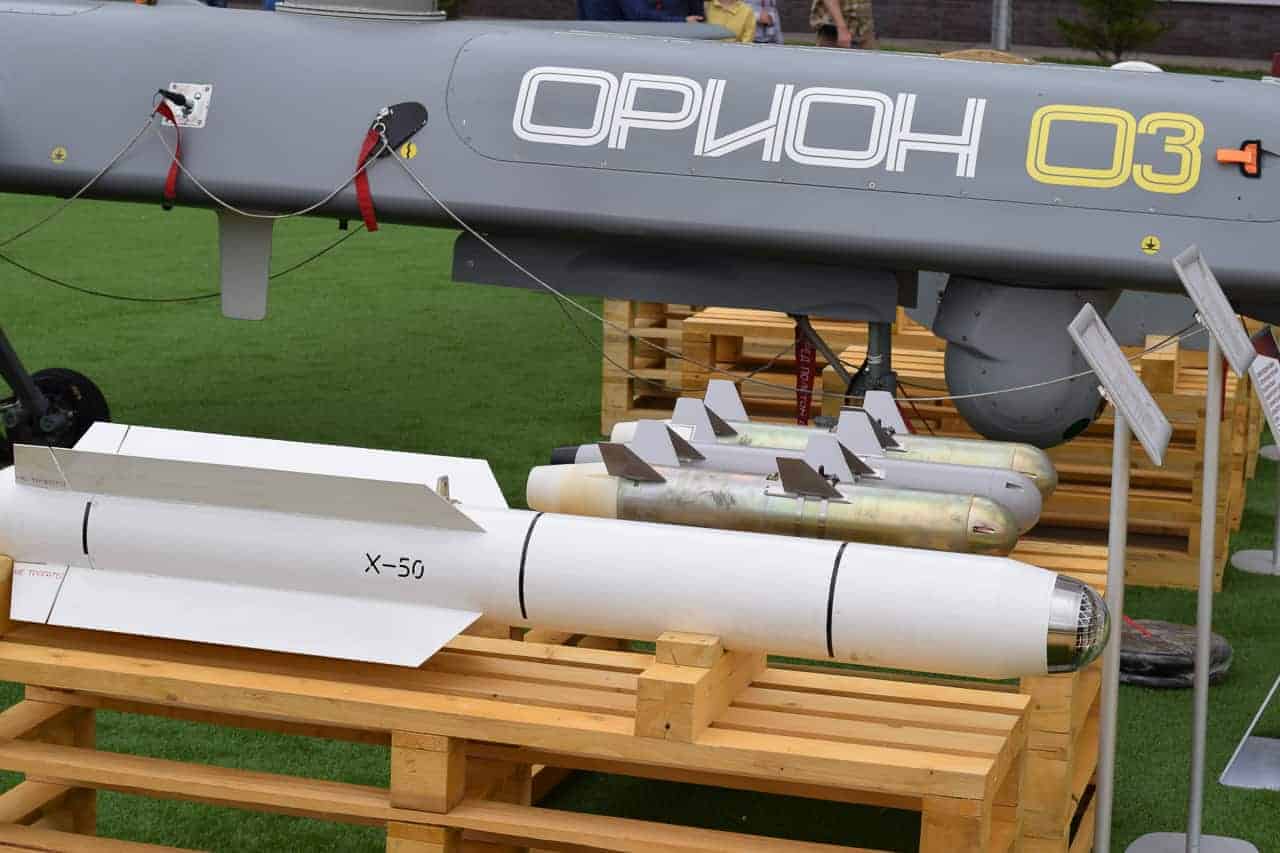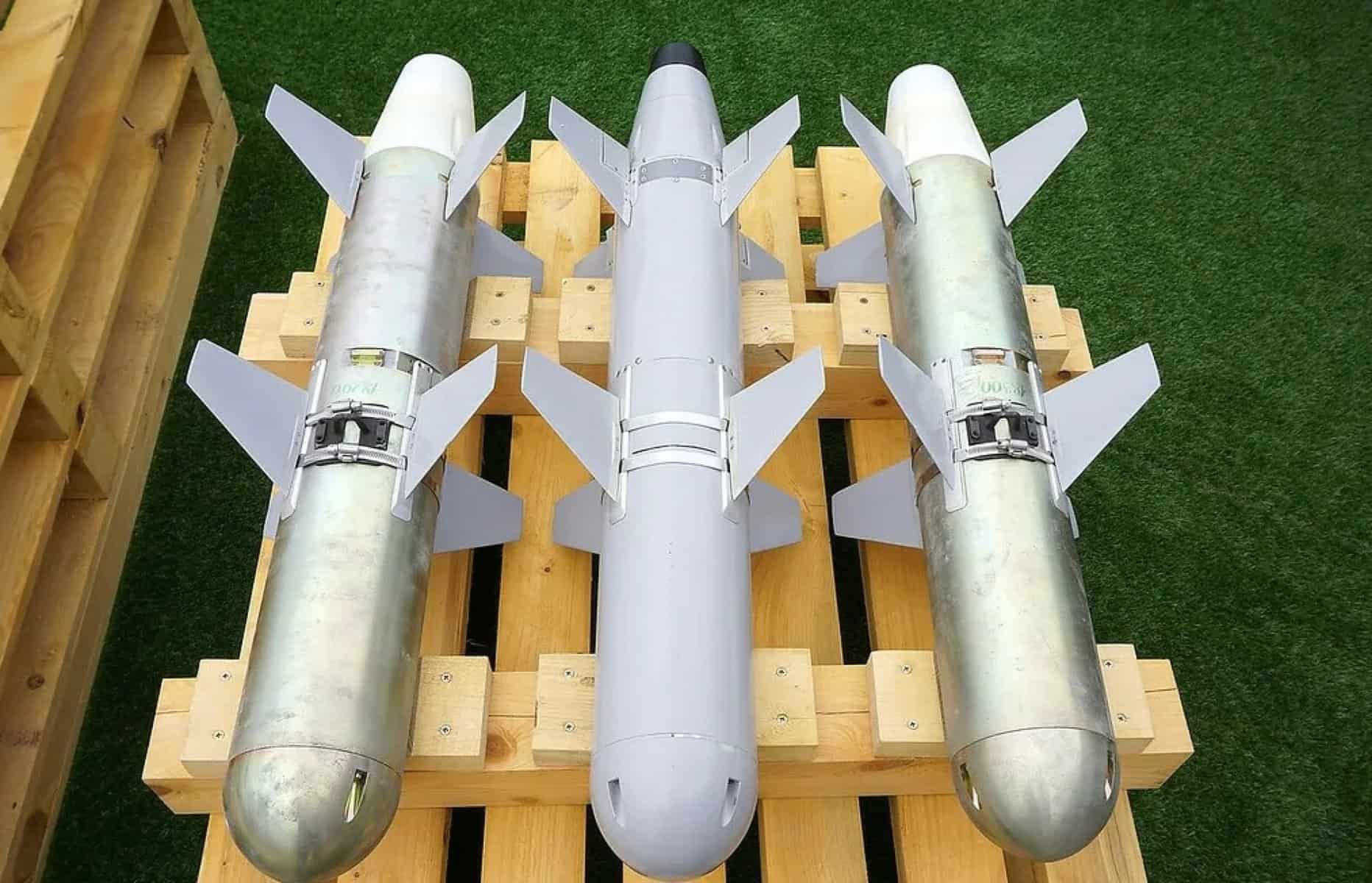
Today, in terms of studying our enemy, we will go over the main types of Russian ammunition for UAVs. They are developed by several organizations. Let’s start with the work of the Central Research Institute of Chemistry and Mechanics (CRICM), because it is the place where the only UAV munition currently produced in a sufficiently large quantity has been created. We are talking about the KAB-20 guided aerial bomb, the first order for serial production of which was placed in August 2021.
The KAB-20 aerial bomb is used by the Forpost-R and Orion unmanned aerial vehicles, the latter of which can carry up to eight KAB-20s.
This is a fairly compact munition (length 900 mm, body diameter 130 mm, wingspan 350 mm). The bomb weighs 21 kg, of which 7 kg is accounted for by the fragmentation warhead. The range of the KAB-20 does not exceed 8 km when dropped from a high altitude.
The munition is produced in two versions – KAB-20L with laser guidance and KAB-20S with satellite guidance (commissioned in April 2023); there may also be a version with guidance on mobile phone signals.

The first Russian specialized ammunition for UAVs that became publicly known were guided bombs from the Kursk-based Aviaavtomatika company, first introduced in August 2017. Actually, these are not really bombs at all, but they are a kind of small disposable drones that best fit under the English-language definition of Air-Launched Effects (ALE).
These bombs have a square-sectioned body to which various wings and plumage can be attached. The MTB-25 bomb weighs 25 kg and can carry up to 17 kg of payload. It has a fixed trapezoidal wing and the same kind of plumage, and its aerodynamic quality is 3, meaning that when dropped from a height of 4 km, it can fly up to 12 km. The guidance system is inertial with satellite correction and a laser or video sensor for precise guidance at the final stage of flight.
The heavier MTB-50 was presented in two versions – with the same trapezoidal wing and with a deployable wing of increased span, which provides a flight range of 5-7 km when dropped from a height of 1 km. Aviaavtomatika allegedly developed similar bombs of 15 and 100 kg caliber, but they were never presented at exhibitions.

The company developed the guided bombs at its own expense, without an order from the Russian Ministry of Defense. The MTB-25 and MTB-50 bombs were repeatedly presented at exhibitions against the backdrop of Orion, Forpost, and Corsair drones. However, nothing has been heard about them for several years now, which means that this program is likely closed.
In contrast to Aviaavtomatika’s conceptually advanced bombs, Kronstadt’s guided bombs are conceptually quite simple as they are built around the warheads of rocket projectiles. The KAB-50 is based on the warhead of a 122-mm Grad missile, and the KAB-100 is based on a 220-mm Uragan missile. These products were first presented in 2018; Kronstadt is allegedly building a plant in Dubna near Moscow to produce them, but so far these munitions have not been used at the front.

Kronstadt bombs are available in different versions, with laser, satellite or video guidance systems (KAB-50L/S/TV). The UPAB-50S variant has a large wing span (900 mm); the KAB-50 has a wing span of 420 mm, and the KAB-100 has a wing span of 430 mm. The weight of the KAB-50 (depending on the variant) is 46-50 kg, the length is 1700-1930 mm; the KAB-100 is 120 kg and 2200 mm, respectively.
In my subjective opinion, these bombs have a very good chance of getting to the battlefield, given the involvement of Kronstadt in the Russian unmanned aerial vehicle program.
And regarding missiles. The Russian “Institute of Applied Physics” proposes to arm drones with a 57-mm S-5U missile. This is not a derivative of the well-known S-5 family of unguided aircraft missiles, but a completely new development, a smaller version of the S-8. The S-5U weighs 6 kg, of which 800 g is the explosive payload. The letter “U” in the designation hints at the versatility of the warhead: when detonated, it produces 490 fragments weighing 2.5 g and is capable of penetrating armor of 120-150 mm.
The launch range reaches 4000 meters. There is only one caveat – the S-5U is unguided! This means that it can hit the target only by accident, given the limited volley from the UAV (for those who have forgotten, let me remind you that the old S-5 was used from helicopters with 32-round missile pods).
Probably, the physicists were unable to implement a laser guidance system in the dimensions of a 57-mm missile. However, such a system has been created for the 80-mm missile – for the S-8L missile. The S-5U was first presented at the Army-2019 show, and the S-8L was presented at Army-2020. There is currently no confirmation of mass production of either the S-5U or S-8L.

The Tactical Missile Defense Corporation (TMDC) offers two models of guided missiles for equipping drones. The first is a product that was first known as the MMM ASP (interspecific small-sized modular interspecific aviation weapon), later as the Izdelie 85, and finally as the Kh-MD. The 110 kg missile has a 30 kg warhead and a range of 40 km (launch altitude of 9000 m, speed of 170 km/h).
The modularity declared in the original name means that the missile can be equipped with one of three guidance heads: active millimeter-wave radar (considered the main one), semi-active laser, and passive radar. The missile is guided by an inertial system with satellite correction during the flight phase.

The other missile is lighter, known as the “Kh-50”. But why the quotation marks? Because this is not an official designation, but a conventional name based on the launch weight of the missile (officially, the Kh-50 is another missile – a new medium-range cruise missile Kh-SD, designed for Tu-22M3, Tu-95MS and Tu-160). The Kh-50 weighs 50 kg, of which 20 kg is accounted for by the warhead. No data on the launch range has been published so far. The guidance system is probably similar to the Kh-MD, with interchangeable guidance elements at the end of the trajectory.
Both the MMM ASP and the Kh-50 have been known since 2020, but have not yet been brought to mass production.
Dear readers, if you found my writing interesting, you can donate a little money for books: https://www.buymeacoffee.com/andrijkhar9
Privatbank: 4731 2196 4166 1818
Підтримати нас можна через:
Приват: 5169 3351 0164 7408 PayPal - [email protected] Стати нашим патроном за лінком ⬇
Subscribe to our newsletter
or on ours Telegram
Thank you!!
You are subscribed to our newsletter